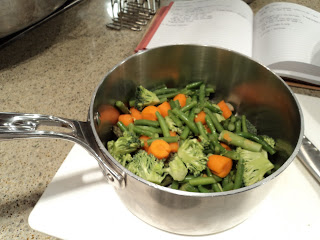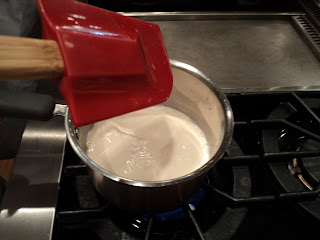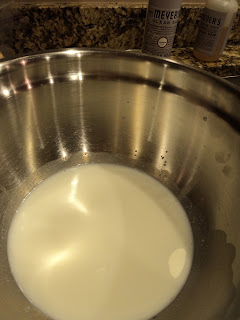B. Reagents:
1 tsp garlic powder
1 tsp onion powder
1 tbsp black pepper
1 tsp thyme
1 tsp parsley
1/4 tsp cayenne pepper
1/2 tsp cumin
1 tsp salt
A. Pork Loin Chops
B. Reagents:
Pork Loin
Dry Rub
C. Procedure:
1. Combine all spices together in small bowl and whisk together.
2. Rub pork loins with dry rub and allow them to rest for about 10 minutes.
3. Grill, broil, bake, or pan fry until cooked through. According to the FDA, an internal temperature of 160o is recommended.
4. Allow pork loin to rest for about 10 minutes.
D. Actual Procedure and Observations:
It will be difficult for me to comment on the actual procedure as I was not involved but I would have to assume that it went just as the recipe describes. The combined spices were rubbed all over the pork pieces and they were allowed to sit for a period of time. They were then sliced in individual servings and grilled.
E. Discussion and Conclusion:
After the cooking is complete (which requires a certain "touch") the next step is crucial. Before slicing into the meat, it must be allowed to rest for about 10-20 minutes. Most people avoid this step as human intuition is to eat it hot off the oven. Doing this is a huge disservice to the quality of the meat once it hits the palate. Why you ask? When meat is cooking the outer surface, called the dry surface as it is quickly dried out upon addition of heat, reaches the temperature of the heat that is being applied to it which can reach up to 400 degrees. The internal portion of the meat can only reach temperature similar to boiling water that is about 100 degress Celsius. As the cooking occurs the juices from the center of the meat are pulled to the outside. These juices cause the rich and intense flavors that assist in the browning reaction of the meat. The outside of the meat typically creates a crusty edge that allows the taste buds a party of flavor. I love meat and I must say that the first bite you get from a crusty piece of meat with tender juices on the inside is just like heaven! Yum. The importance of allowing the meat to sit after being removed from heat is all about the juices. The juices are pulled from center to the outside during the cooking process and then once removed from heat they are allowed to settle back into the cells of the meat and in the fibers. If cut immediately after cooking the juices will run out onto the plate being lost from the meat itself. If allowed to cool the juices will evenly distribute to the tissues of the meat allowing for an even distribution and giving each bite the tenderness and juiceiness that it deserves. One last important factor when dealing with meat is the knife that you use to cut it. A sharp knife must be used to protect the integrity of the fibers that were allowed to reconstruct with the resting of the meat.
Cooking Vegetables Three Different Ways
A. Roasted Vegetables
B. Reagents:
1 cup root vegetables, peeled and cut into one inch pieces
1 tbsp vegetable oil
salt and pepper to taste
C. Procedure:
1. In a large bowl toss the vegetables and oil together to coat. Salt and pepper to taste.

2. Place onto a prepared baking sheet and roast at 400 degrees for about 30 minutes or until cooked through.
3. Add salt and pepper to taste.

D. Actual Procedure and Observations:
I have never roasted vegetables in the oven as I am very used to blanching the veggies and then tossing them to the sautee but I do believe this is going to be my new choice of preparation. I chopped all of the vegetables in about 1 inch pieces and placed them all in a bowl. I then drizzled them with olive oil and added salt and pepper. They were baked in a pre-heated oven for about 25 mintues.
E. Discussion and Conclusion:
I was originally worried that I had over salted the veggies and that they would taste awful but fortunately for me they cooked long enough to have a bit of a crisp to them and with the extra salt they tasted almost like chips! I was so sad that we had to add them to pot of veggies for everyone to eat as I am positive ours were the best! (No offense to the other members of the class as they are all great people and should not be judged on their ability to roast veggies as amazing as I have.) The reason why these veggies turned out so amazing is due to the caramelizing reaction. This happens when the oil and the natural sugars of the vegetables seep out of the vegetable and with the heat provide a sweet, caramel and golden brown flavor and color. These were by far my favorite veggies of the evening. Yum.
A. Boiled Root Vegetables
B. Reagents:
1 cup root vegetables, peeled and cut into one-inch pieces
salt and pepper to taste
C. Procedures:
1. Place vegetables into a sauce pan and cover with about an inch of cold water.

2. Bring to water to a boil, reduce heat, and simmer until vegetables are tender (about 10 minutes)
3. Add salt and pepper to taste.

D. Actual Procedure and Observation:
These veggie recipes are the most simple recipes that we have had to do all semester. We cleaned, cut, diced and added the veggies to a pot of water. Added heat, reduced heat, simmered and drained. Season to taste and eat.
E. Discussion and Conclusion:
The interesting thing about boiling vegetables is that they immediatley turn to an intense and vibrant color when first added to the hot water. This occurs because of the immediate expansion and release of gases which are trapped in the spaces that sit between the cells. These pockets of air dim and refract the color of the chloroplasts. When these pockets are heated they collapse and the pigments can be seen much more clearly. Unfortunately, the vegetables require a bit more time with heat to cook which pushes past this vibrant color phase and moves into a dull and depressing hue. The main reason for this is due to the replacement of magnesium by hydrogen in the cells of the vegetables. This process damages the cell structure and allows for the plant's own acids into contact with chlorophyll. Depressing! There is a way to prevent this from happening in the cooking process. If alkaline water is used in the cooking process it limits the available hydrogen ions which will restore the color to the veggies.
A. Steamed Vegetables
B. Reagents:
1 cup root vegetables, peeled and cut into one-inch pieces
salt and pepper to taste
C. Procedure:
1. Place vegetables into a steamer, cover, and steam for about 20 minutes or until tender.

2. Add salt and pepper to taste.

D. Actual Procedure and Observations:
The procedure of this recipe is also very easy as compared to the boiled vegetables. Prepare veggies and add to the steamer.
E. Discussion and Conclusion:
The chemistry behind this recipe is exact to that of the boiled veggies. The difference is the method that is used. In boiling, a lot of the vitamins and minerals found in the plant are thought to be lost in the boiled water. With the steamed, the plants are not sitting in water allowing for less of a loss of the nutrients.
A. Garlic Infused Balsamic Vinaigrette
B. Reagents:
2 tbsp balsamic vinegar
¼ cup canola oil
1 tbsp minced garlic
2 tsp Dijon mustard
Salt and pepper
Salad greens
C. Procedure:
1. Whisk together the garlic, balsamic vinegar, and Dijon mustard.
2. SLOWLY add the oil almost one drop at a time.
3. Add salt and pepper to taste.
4. Just before service, dress salad, toss, and serve.
D. Actual Procedure and Observations:
Although I wasn't responsible for making this recipe, I did watch as the group next to us did. It reminded me a lot of the recipe that we did on the first day of class...mayo. The group made sure to add the oil slowly as the recipe directs and as we learned with the mayonaise recipe, this is crucial.
E. Discussion and Conclusion:
The mustard serves as a bit of an emulsifier. Although the recipe is void of the egg yolk which is the main emulsifier, the mustard is a partial emulsifier that provides a thickening agent to the dressing. The oil must be added painfully slowly. If dumped in all at once it will take over the other ingredients. By whipping the oil in slowly and sufficiently, a thicker and more cohesive mixture is formed.



































